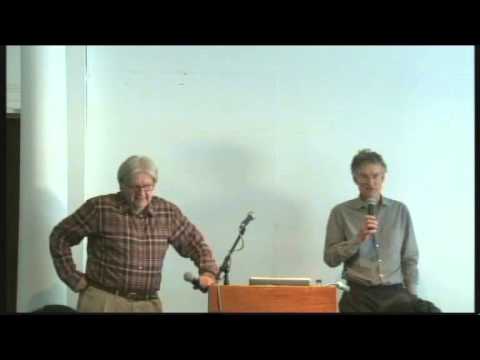
Lecture date: 2010-05-21
Mark Cousins introduces Adrian Forty, who announces a very pragmatic talk; not offering thoughts about the nature of truth, the past, time or any of the other big questions. At the start of every academic year, he finds himself in front of an audience of 150 of new students and he presents to them a course on the history of Architecture and Cities, feeling that he has to offer some explanation as to why they are having a history course. He says to them that they are young people, going to school in order to make new things, so why should they be concerned with the past? Surely, he reminds, it is only declining civilizations that become obsessed with the past. Memories are the last refuge of those who are getting old, who have nothing else to look forward to. He finds it a very interesting question, which he has never fully satisfied himself, but in that situation in the beginning of the year, he feels he has to provide certain answers. One of them, is to do with the nature of the subject that they are concerned with; buildings and cities. He thinks it is useful to think about how study of architecture and the city differs from other disciplines. If one takes some disciplines, like engineering or economics, the knowledge in those fields consists of a body of theory, which people learn and which they learn how to reply in given situations. Architecture and building are not like that; the knowledge in architecture and building consists in the buildings and cities that are there. This is not to say that we can’t have theories about them, but ultimately the text about those theories is what is actually there. If you want to know what a wall is, or an opening is, you have to look, in a sense at all walls and at all openings. The knowledge is in the objects. This seems to him to put architecture apart from other theoretically based disciplines and more like some others, like medicine. In medicine, knowledge is ultimately knowledge of the body: there are theories on how the body works, but those theories are only good if they correspond with the experience, the physiognomy and the processes of the body. Taking the analogy further, what you do if you are a medical student is that you are presented with a dead body, a cadavre and you have to dissect it. You spend your first three months taking it apart, slowly, methodically, recording everything that you see. That is the beginning. There is some kind of equivalent that is needed for students of architecture and the cities, they too, need to know what the material in which they are operating is. In one way, it could be said that the best possible thing to do is a year-long grand tour, in which they see as much as it is possible in the space of a year. Maybe, it would be one solution to it. However, there are certain drawbacks to that as a way to presenting an education, he is not sure if it would really work, because it is not only about going to see something, but, what do you see when you get there? We probably all have the experience of going to a supposedly great work of architecture and finding that when we get there, we feel like, what is this all about? What is in it? You go away, puzzled and you write that off: perhaps it is not so great after all. The problem is that we don’t have any innate, natural ability to read buildings and cities; they are notoriously resistant to understanding, they don’t give up their meanings easily. Certainly, it wouldn’t be possible to expect that those arriving at the school of architecture at the age of eighteen, however bright and well educated they might be, have the means to make sense of what they are seeing, even if the professor got them to see all these works around the world. There is a need to give people the apparatus, with which to make sense of what they see. This capacity to see and realize that buildings can carry thoughts, is something for which people have to acquire a skill. A history course provides some means in order to make sense of what people see. How does one do that, there are many possibilities. But I wonder how many students have made the journey to visit St. George’s Bloomsbury church, which is 4 min walk from AA. There is a kind of agoraphobia that is set among architecture students. In which their focus on their laptops, in their place in the studio and have a kind of terror of going out and seeing anything. One of the main challenges of teaching in a school of architecture, for Adrian, it is actually getting people out of the school of architecture, and to confront solid matter out there. Part of the task of the architecture course is to make people to feel relaxed about engaging with actual buildings and the city. So, what should we teach? He gives a scenario: w